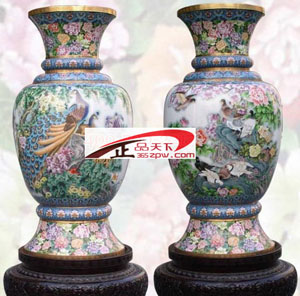"The Cloisonné 'Hundred Birds Paying Homage to the Phoenix' Vase"
Since the founding of new China for more than 60 years, only representative works of Qi Baishi, Xu Beihong, Huang Binhong and other artists renowned at home and abroad have been adopted by China Post as stamp patterns and publicly issued. Master Dai Jialin has made remarkable contributions to the inheritance and development of cloisonné national art. Based on this, China Post has specially approved Master Dai Jialin's peak work in his 50-year artistic career, "Phoenix Vase with a Hundred Birds", cloisonné as commemorative stamp pattern and publicly issued. This is a full affirmation of Master Dai Jialin's artistic achievements.
Cloisonné is a rare gem in Chinese arts and crafts, and one of the famous "Eight Yanjing Arts" of arts and crafts, which are as famous as jade carving, ivory carving, filigree inlay, gold lacquer inlay, carved lacquer, inner painting, and lacquer painting. Cloisonné was a treasure-level heavy object in history and was once more valuable than jade and jewels. Cloisonné has the momentum of bronze ware, the splendid color of silk brocade, and the bright and smooth texture of porcelain. Cloisonné was once a precious object in the Ming and Qing courts, and there were special institutions set up in the palace for the production of cloisonné. In the Ming Dynasty, it was managed by the Neiwu Bureau, and in the Qing Dynasty, there was a special "F琅ng Workshop" set up in the Imperial Workshops to be responsible for cloisonné production. Cloisonné was once a luxury item, a special product for the royal family and princes, and ordinary people could not see it. The emperor occasionally gave it as a gift to ministers, and princes and ministers boasted of their favor and nobility if they could place a piece of cloisonné at home. Therefore, cloisonné has the reputation of being "more precious than jewelry and jade." At the 1904 World's Fair in Chicago, USA, and the 1915 Panama International Exposition, cloisonné won awards twice.
As a court art, cloisonné is a noble decorative art in the Ming and Qing palaces, monopolized by the royal family. After more than 600 years of development, cloisonné has become an extremely important chapter in the history of Chinese arts and crafts, known as the essence of Chinese culture, and has been listed as intangible cultural heritage of the country. For this reason, ordinary people have almost no chance to come into contact with cloisonné, which also greatly restricts the inheritance and development of this essence art. In recent auction sessions, the price of traditional cloisonné has far exceeded that of other categories of artworks.
The production process of cloisonné is complex and mysterious, with more than ten main processes such as making the base, threading, welding, dotting blue, firing blue, polishing, and gilding. If all the small processes are counted, a single product goes through 108 processes, and all are meticulously handmade. What amazes people most is the threading and dotting blue. Threading masters can use just a pair of small tweezers to twist and turn soft but resilient flat wires into a dragon body, a phoenix head, a peony flower, or a lily plant. Then they stick each flat wire onto the copper base, much like the white-line drawing in painting, except it uses wire instead of a brush. A bare copper base, after being decorated by the threading artisans with "ingenious heart and skilled hands," transforms into a myriad of patterns such as landscapes, figures, seasonal flowers blooming, dragons flying, phoenixes dancing, leaping vividly onto the base, resembling a three-dimensional painting waiting to be colored.
The dotting blue process is even more amazing. In front of each dotting blue master are hundreds of small plates filled with enamel colors. They use a special tool called "blue gun and pipette" to fill different colors drop by drop into the spaces between the wires embedded on the base. The wires act as boundaries to separate the colors. After repeated three or four rounds of dotting blue and firing, the surface of the completed product resembles a watercolor painting. If threading is compared to line drawing in painting, then dotting blue is akin to coloring in painting.
Firing blue adds a sense of mystery. When the firing master takes out a freshly fired product from a furnace at 700 degrees Celsius, the red-hot scene is spectacular, but the red quickly fades to brown, and as the heat cools, it gradually restores to its original color. The powder-like surface turns into a crystal-clear, glossy solid substance, more transparent than jade, and more dazzling than amber. The firing process may seem simple, but it is not. Due to the different metal elements contained in various colored enamels, their melting points vary. Whether it's one or two minutes, or two or three minutes, controlling the time of firing in the fire to make the enamel melt perfectly depends entirely on the eyesight of the master in front of the furnace. A product undergoes at least 10 rounds of fire trials from the first process to completion. If there is a problem in any one round of firing, it is difficult to repair, and sometimes all previous efforts will be wasted.
The national issuance of "Hundred Years Phoenix Vase" cloisonné is limited to 300 pieces. Each piece comes with authoritative certificates personally signed by Master Dai Jialin, including a collection certificate, supervision certificate, anti-counterfeiting certificate, and notarization certificate, as well as a personalized stamp sheet specially issued by China Post using the pattern of this work.
